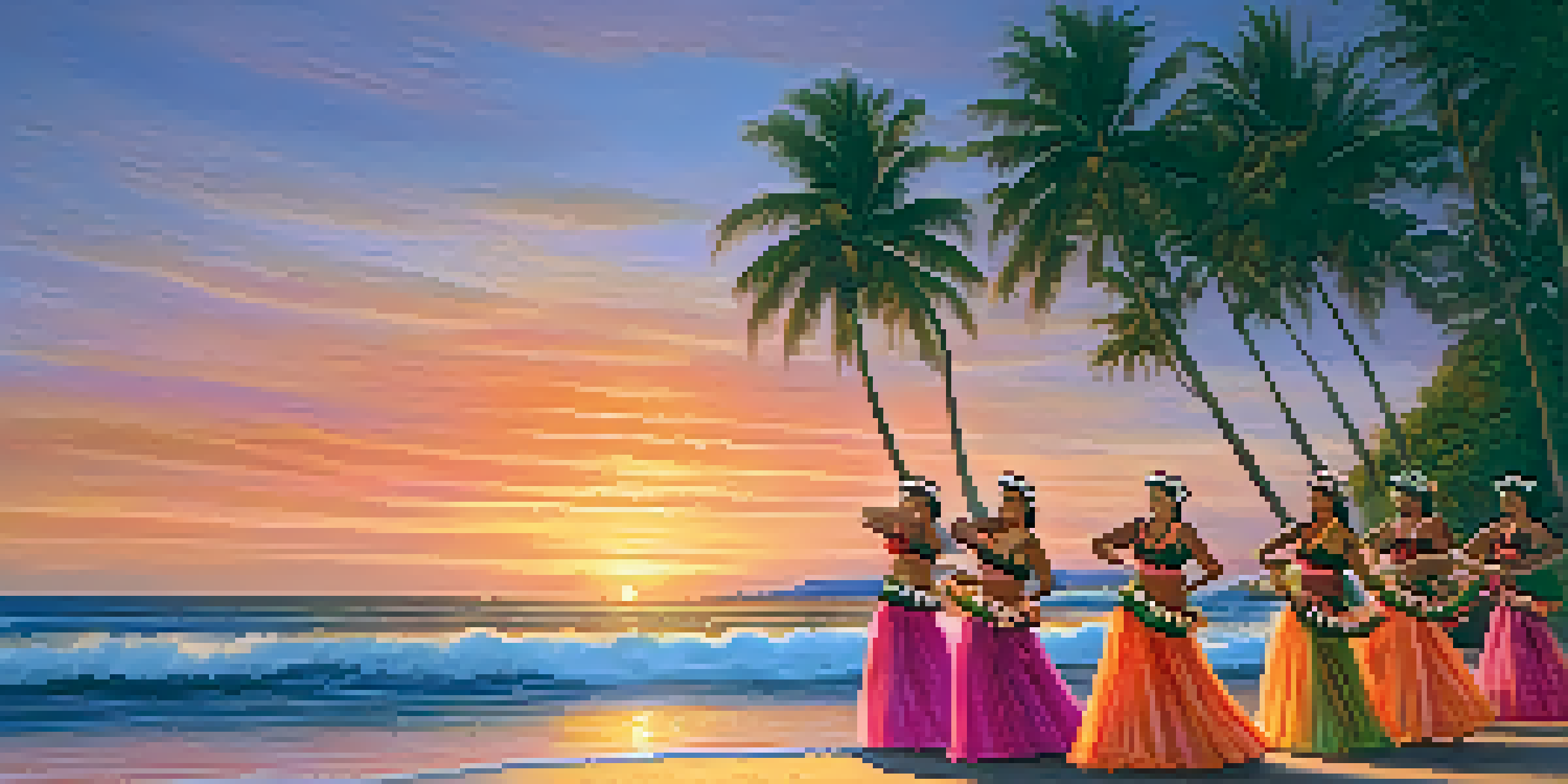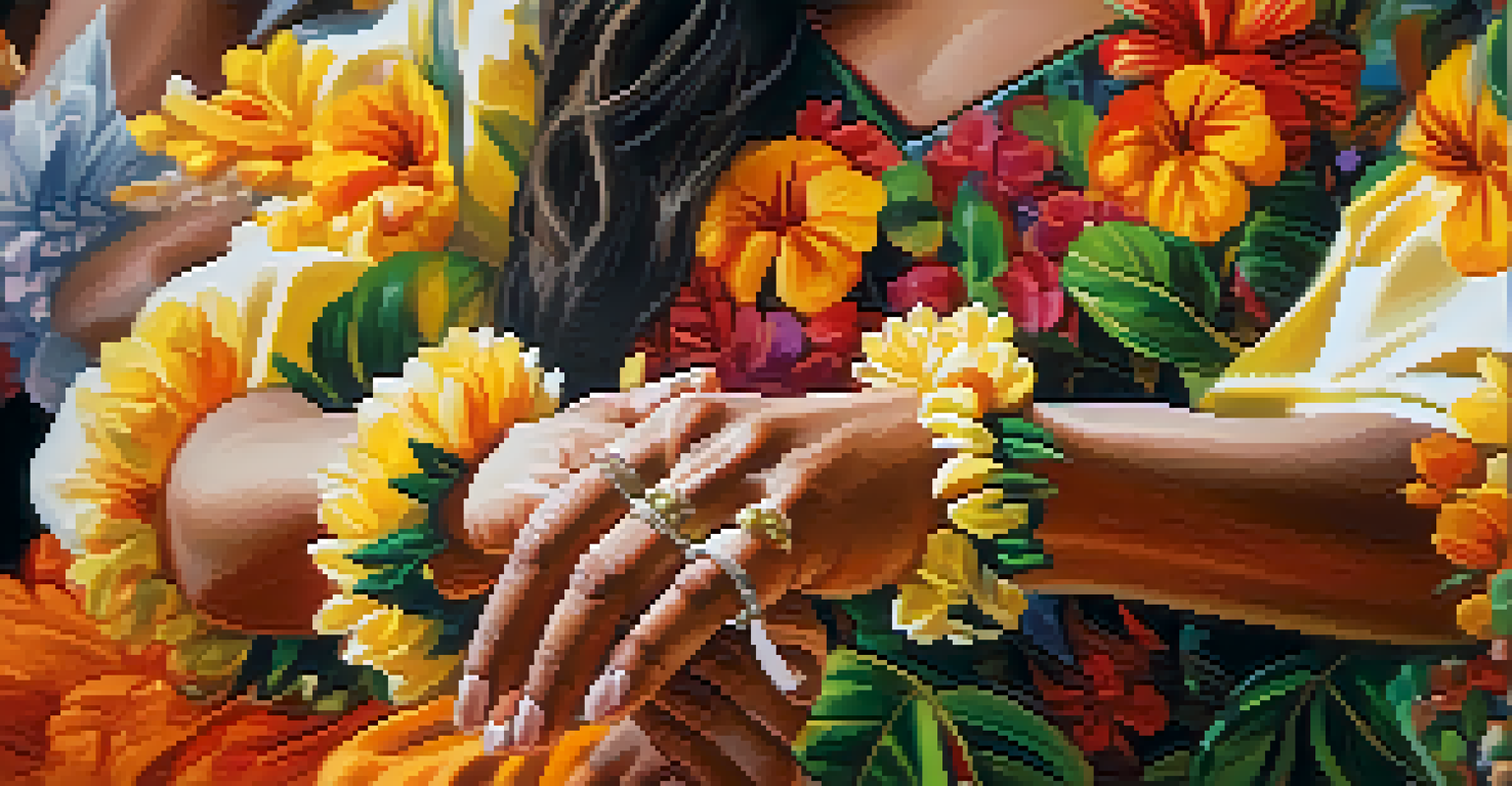Exploring the Origins of Hawaiian Dance Beyond Traditional Hula

Understanding Hula's Cultural Significance
Hula is often the first dance that comes to mind when we think of Hawaiian culture. This traditional dance form, with its rhythmic movements and storytelling, plays a significant role in preserving Hawaiian history and traditions. It's not just about the dance; it's about connecting with the land, ancestors, and community.
Hula is the memory of the Hawaiian people, their past, their present, and their future.
However, hula is just one piece of a larger mosaic of Hawaiian dance. While hula has gained international recognition, many other dance forms reflect the rich diversity of Hawaiian culture and its history. These variations often tell stories that are equally compelling and culturally significant.
Understanding the importance of hula allows us to appreciate the broader spectrum of Hawaiian dance forms. Each dance style offers a unique lens into the island's heritage, providing context to the stories and traditions that shape the Hawaiian identity.
The Influence of Polynesian Dance Forms
Hawaiian dance is deeply rooted in the broader context of Polynesian culture. Dances from other islands, such as Tahiti and Samoa, have influenced Hawaiian styles, creating a vibrant blend of movements and rhythms. This interconnectedness showcases the shared heritage of the Polynesian people.

For example, Tahitian dance, known for its fast-paced hip movements and vibrant costumes, contrasts with the flowing motions of hula. Yet, both styles celebrate the beauty of nature and life, illustrating how different cultures can express similar themes through dance. This cross-pollination of dance forms enriches the Hawaiian dance landscape.
Hula's Cultural Importance
Hula plays a vital role in preserving Hawaiian history and traditions, connecting the community with its land and ancestors.
By exploring these Polynesian influences, we gain insight into Hawaiian dance's evolution. It highlights the adaptability and resilience of these cultures, demonstrating how they maintain their unique identities while embracing elements from one another.
Contemporary Hawaiian Dance: A Modern Twist
In recent years, contemporary Hawaiian dance has emerged as a dynamic and innovative form of expression. Dancers are weaving in modern themes, styles, and even hip-hop influences into traditional movements, creating a fresh narrative that resonates with younger generations. This evolution shows that dance is not static; it’s a living art form that continues to grow.
Dance is the hidden language of the soul.
One popular contemporary style is 'Hawaiian hip hop,' which incorporates traditional Hawaiian movements and music with modern hip hop beats. This fusion not only keeps the dance relevant but also engages new audiences, helping to bridge the gap between tradition and modernity.
As contemporary Hawaiian dance gains popularity, it encourages a dialogue about identity and culture. Dancers are embracing their heritage while also making space for new interpretations, ensuring that Hawaiian dance remains vibrant and relevant in today’s world.
The Role of Dance in Hawaiian Spiritual Practices
Dance in Hawaiian culture is often intertwined with spiritual practices, serving as a form of worship and connection to the divine. Many dances are performed as offerings to the gods or to honor nature, demonstrating the deep spiritual significance behind each movement. This sacred aspect of dance elevates it beyond mere entertainment.
For instance, the ancient practice of 'Hula Kahiko' is performed in traditional attire and accompanied by chants that recount stories of the gods and ancestors. This form of hula is not just about the dance itself but also about the spiritual and cultural narratives it carries.
Influence of Polynesian Dance
Hawaiian dance is enriched by the diverse influences of other Polynesian cultures, showcasing a shared heritage and adaptability.
By understanding the spiritual dimensions of Hawaiian dance, we appreciate the profound respect for nature and the divine that permeates these performances. It reminds us that dance is a powerful medium for expressing beliefs and values within the community.
Regional Variations in Hawaiian Dance Styles
Hawaiian dance is not monolithic; different islands have their own unique styles and interpretations. For example, the dances of Maui often incorporate fast footwork and energetic movements, while dances from the Big Island may emphasize slower, graceful motions. These regional variations enrich the overall tapestry of Hawaiian dance.
Each island’s dance reflects its unique history, geography, and cultural influences. For instance, the impact of local legends, historical events, and even the environment can shape how dance is performed and taught. This diversity contributes to a rich cultural exchange among the islands.
Exploring these regional differences enhances our understanding of Hawaiian culture. It showcases how a shared heritage can manifest in varied forms, illustrating the adaptability and creativity of the Hawaiian people.
Celebrating Hawaiian Dance Festivals and Competitions
Hawaiian dance festivals and competitions play a vital role in preserving and promoting these art forms. Events like the Merrie Monarch Festival celebrate hula and encourage dancers to showcase their skills, creativity, and cultural knowledge. Such gatherings foster a sense of community and pride among participants and audiences alike.
These festivals are not just competitions; they are celebrations of culture, history, and artistry. Participants often prepare for months, ensuring their performances honor their heritage while also pushing creative boundaries. The excitement and camaraderie among dancers create an electric atmosphere that speaks to the heart of Hawaiian culture.
Future of Dance: Tradition Meets Modern
The evolution of Hawaiian dance reflects a blend of tradition and contemporary styles, ensuring cultural relevance for future generations.
By attending these events, audiences gain insight into the depth and beauty of Hawaiian dance. They offer a unique opportunity to witness the evolution of dance while appreciating its roots, connecting generations through shared experiences.
The Future of Hawaiian Dance: Bridging Tradition and Innovation
As we look to the future, Hawaiian dance continues to evolve while honoring its rich traditions. Dancers and choreographers are increasingly blending contemporary elements with traditional practices, ensuring that the art form remains relevant and engaging. This balance between preserving heritage and embracing change is crucial for cultural sustainability.
Educational initiatives are also playing a significant role in this evolution. Schools and community programs are incorporating Hawaiian dance into their curriculums, teaching young people the importance of their cultural heritage. This not only preserves traditional practices but also inspires a new generation of dancers.

Ultimately, the future of Hawaiian dance lies in the hands of its practitioners. By fostering a spirit of creativity and respect for tradition, the dance community can continue to thrive, bridging the gap between past and present while paving the way for future innovations.